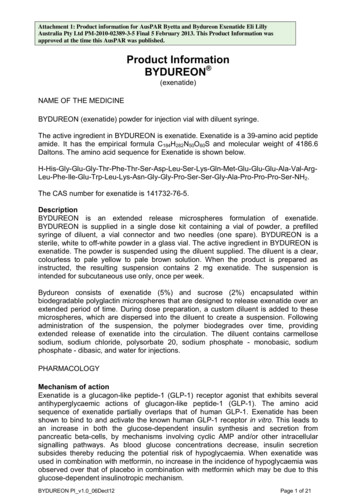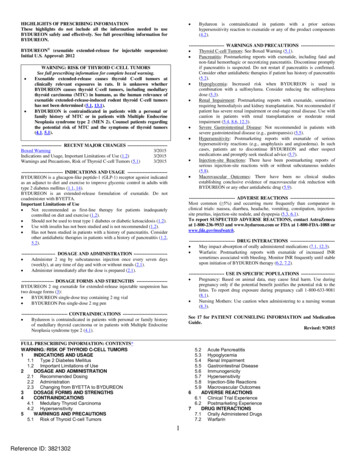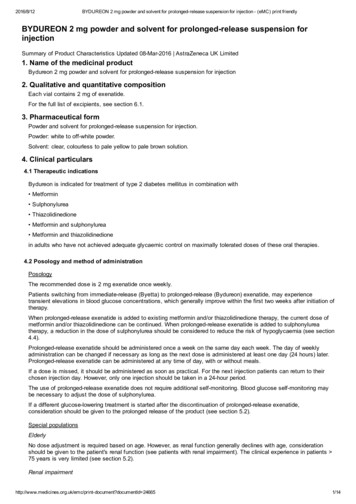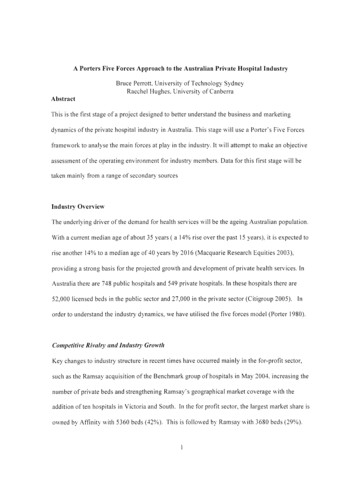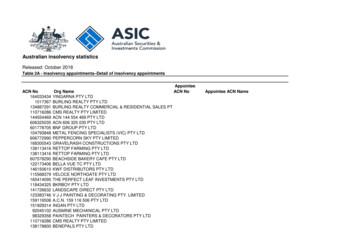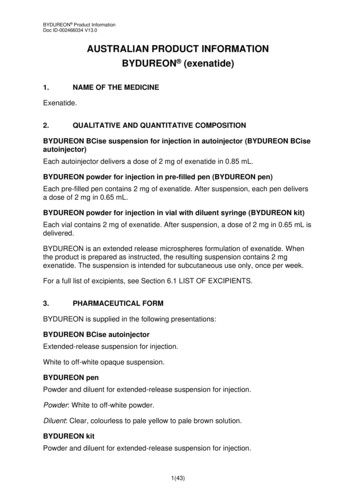
Transcription
BYDUREON Product InformationDoc ID-002466034 V13.0AUSTRALIAN PRODUCT INFORMATIONBYDUREON (exenatide)1.NAME OF THE MEDICINEExenatide.2.QUALITATIVE AND QUANTITATIVE COMPOSITIONBYDUREON BCise suspension for injection in autoinjector (BYDUREON BCiseautoinjector)Each autoinjector delivers a dose of 2 mg of exenatide in 0.85 mL.BYDUREON powder for injection in pre-filled pen (BYDUREON pen)Each pre-filled pen contains 2 mg of exenatide. After suspension, each pen deliversa dose of 2 mg in 0.65 mL.BYDUREON powder for injection in vial with diluent syringe (BYDUREON kit)Each vial contains 2 mg of exenatide. After suspension, a dose of 2 mg in 0.65 mL isdelivered.BYDUREON is an extended release microspheres formulation of exenatide. Whenthe product is prepared as instructed, the resulting suspension contains 2 mgexenatide. The suspension is intended for subcutaneous use only, once per week.For a full list of excipients, see Section 6.1 LIST OF EXCIPIENTS.3.PHARMACEUTICAL FORMBYDUREON is supplied in the following presentations:BYDUREON BCise autoinjectorExtended-release suspension for injection.White to off-white opaque suspension.BYDUREON penPowder and diluent for extended-release suspension for injection.Powder: White to off-white powder.Diluent: Clear, colourless to pale yellow to pale brown solution.BYDUREON kitPowder and diluent for extended-release suspension for injection.1(43)
BYDUREON Product InformationDoc ID-002466034 V13.0Powder: White to off-white powder.Diluent: Clear, colourless to pale yellow to pale brown solution.Exenatide is also available in an immediate-release formulation (BYETTA). Forinformation related to this formulation, please refer to the BYETTA ProductInformation.4.CLINICAL PARTICULARS4.1THERAPEUTIC INDICATIONSBYDUREON is indicated for the treatment of type 2 diabetes mellitus to improveglycaemic control in combination with other glucose-lowering medicinal productswhen the therapy in use, together with diet and exercise, does not provide adequateglycaemic control (see Section 5.1 PHARMACODYNAMIC PROPERTIES - Clinicaltrials for available data on different combinations).4.2DOSE AND METHOD OF ADMINISTRATIONThe recommended BYDUREON dose is 2 mg exenatide once weekly. Titration is notrequired. BYDUREON is for single-use in one patient only. Discard any residue.BYDUREON can be administered at any time of day, with or without meals.After suspension, use BYDUREON only if the mixture is white to off-white andcloudy. Each dose should be administered in the abdomen as a subcutaneousinjection immediately after suspension of the powder in the diluent. BYDUREONmust not be administered intravenously or intramuscularly.When used in combination with insulin, BYDUREON and insulin must beadministered as two separate injections. It is acceptable to inject BYDUREON andinsulin in the same region of the body, but the injections should not be adjacent toeach other.BYDUREON kit and pen must be injected immediately after suspension of thepowder in the diluent. BYDUREON BCise autoinjector must be injected immediatelyafter mixing the suspension.Changing weekly dosing scheduleThe day of weekly administration can be changed if necessary as long as the lastdose was administered 3 or more days before.Missed doseIf a dose is missed, it should be administered as soon as noticed, provided the nextregularly scheduled dose is due at least 3 days later. Thereafter, patients canresume their usual dosing schedule of once every 7 days (weekly).If a dose is missed and the next regularly scheduled dose is due 1 or 2 days later,the patient should not administer the missed dose and instead resume BYDUREONwith the next regularly scheduled dose.2(43)
BYDUREON Product InformationDoc ID-002466034 V13.0Use in combination therapyBYDUREON is recommended for use in patients with type 2 diabetes mellitus whoare already receiving metformin and/or a sulfonylurea.When BYDUREON is added to existing metformin therapy, the current dose ofmetformin can be continued as no increased risk of hypoglycaemia is anticipated,compared to metformin alone.When BYDUREON is added to sulfonylurea therapy, a reduction in the dose ofsulfonylurea should be considered to reduce the risk of hypoglycaemia (see Section4.4 SPECIAL WARNINGS AND PRECAUTIONS FOR USE).When BYDUREON is added to dapagliflozin, no dose adjustment is required.When BYDUREON was added to a basal insulin, no initial dose adjustment of insulinwas required if the fasting blood glucose level was in the target range.BYDUREON can be used in addition to metformin and basal insulin. In a clinical trialwith basal insulin, patients ceased therapy with a sulfonylurea – there are no data onthe risk/benefit of continuing sulfonylurea therapy.Switching from BYETTA to BYDUREONPatients switching from BYETTA (10 mcg exenatide twice daily) to BYDUREON(2 mg exenatide once weekly) may experience transient elevations in blood glucoseconcentrations, which generally improve within the first two weeks after initiation oftherapy.Switching between BYDUREON kit or pen to BYDUREON BCise autoinjectorPatients switching between BYDUREON kit or pen and BYDUREON BCiseautoinjector may do so, with minimal expected effect on blood glucoseconcentrations.MonitoringThe use of BYDUREON does not require additional self-monitoring. However, whenused in combination with a sulfonylurea, or insulin, blood glucose self-monitoringmay be necessary to monitor for hypoglycaemia and to titrate the doses of insulin orsulfonylurea.DiscontinuationFollowing discontinuation, consideration should be given to the prolonged release ofexenatide (see Section 5.2 PHARMACOKINETIC PROPERTIES).Specific patient groupsElderlyBYDUREON can be given to adults of all ages including the elderly ( 65 years ofage) (see Section 4.4 SPECIAL WARNINGS AND PRECAUTIONS FOR USE and5.2 PHARMACOKINETIC PROPERTIES).3(43)
BYDUREON Product InformationDoc ID-002466034 V13.0Patients with renal impairmentBYDUREON can be given to patients with mild or moderate renal impairment(creatinine clearance 30 – 80 mL/min) (see Section 5.2 PHARMACOKINETICPROPERTIES).BYDUREON is not recommended for use in patients with end stage renal disease orsevere renal impairment (creatinine clearance 30 mL/min) (see Section 5.2PHARMACOKINETIC PROPERTIES).Patients with hepatic impairmentBYDUREON can be given to patients with hepatic impairment (see Section 5.2PHARMACOKINETIC PROPERTIES).Children and adolescentsThe safety and efficacy of exenatide have not yet been established in children under18 years of age (see Section 5.2 PHARMACOKINETIC PROPERTIES).Instructions for use and handlingBYDUREON is for use by one person only.The instructions for the user containing the complete preparation and administrationinstructions must be followed carefully.The diluent should be visually inspected prior to use. Use the diluent only if it is clearand free of particulate matter. After suspension, use BYDUREON only if the mixtureis white to off-white and cloudy.BYDUREON should be used only with the supplied custom needles.BYDUREON kit and pen must be injected immediately after suspension of thepowder in the diluent. BYDUREON BCise autoinjector must be injected immediatelyafter mixing the suspension.BYDUREON that has been frozen must not be used.BYDUREON should not be used past the expiration date.The patient should be instructed to discard the syringe, pen, or autoinjector with theneedle still attached after each injection in an appropriate needle bin and return,along with any unused medicinal product or waste material to pharmacists ordiabetes nurse educators for disposal. The patient does not need to put the coverback on the needle or to save any part of the single-use kit, single-use pen, orsingle-use autoinjector.4.3CONTRAINDICATIONSBYDUREON is contraindicated in patients with known hypersensitivity to this productor any of its components (see Section 6.1 LIST OF EXCIPIENTS).4(43)
BYDUREON Product InformationDoc ID-002466034 V13.0BYDUREON should not be used in patients with end-stage renal disease or severerenal impairment (creatinine clearance 30 mL/min). Compared with healthysubjects, renal clearance of exenatide was significantly reduced in patients with endstage renal disease receiving dialysis, resulting in poor gastrointestinal tolerability.4.4SPECIAL WARNINGS AND PRECAUTIONS FOR USEGeneralBYDUREON should not be used in patients with type 1 diabetes mellitus or for thetreatment of diabetic ketoacidosis.BYDUREON must not be administered by intravenous or intramuscular injection.BYDUREON has not been studied in patients with severe gastrointestinal disease,including gastroparesis. Its use is commonly associated with gastrointestinal adverseeffects, including nausea, vomiting, and diarrhoea. Therefore, the use ofBYDUREON is not recommended in patients with severe gastrointestinal diseaseincluding gastroparesis and dumping syndrome.The concurrent use of BYDUREON with prandial insulin, D-phenylalaninederivatives, meglitinides, alpha-glucosidase inhibitors, dipeptidyl peptidase-4inhibitors (“gliptins”), orlistat, opioids, and anticholinergics has not been studied. Theconcomitant use of BYDUREON and other GLP-1 receptor agonists is notrecommended (see Section 4.2 DOSE AND METHOD OF ADMINISTRATION).HypoglycaemiaAs would be expected for a blood glucose lowering agent, when exenatide was usedin combination with a sulfonylurea; the incidence of hypoglycaemia was increasedover that of placebo in combination with a sulfonylurea. In the clinical studiesincluding patients on a sulfonylurea combination, those with mild renal impairmenthad an increased incidence of hypoglycaemia compared to patients with normalrenal function. To reduce the risk of hypoglycaemia associated with the use of asulfonylurea, reduction in the dose of sulfonylurea may be considered (see Section4.2 DOSE AND METHOD OF ADMINISTRATION and Section 4.8 ADVERSEEFFECTS (UNDESIRABLE EFFECTS)).Exenatide did not alter the counter-regulatory hormone response to insulin-inducedhypoglycaemia in a randomised, double-blind, controlled study in healthy subjects.Interaction with warfarinSince market introduction there have been some spontaneously reported cases ofincreased INR (International Normalized Ratio) with concomitant use of warfarin andexenatide, sometimes associated with bleeding (see Section 4.5 INTERACTIONSWITH OTHER MEDICINES AND OTHER FORMS OF INTERACTIONS and Section4.8 ADVERSE EFFECTS (UNDESIRABLE EFFECTS)).Altered renal functionThere have been rare, spontaneously reported events of acute renal failure,worsened chronic renal failure, renal impairment, or increased serum creatinine5(43)
BYDUREON Product InformationDoc ID-002466034 V13.0among patients using exenatide. These events mostly occurred in patients alsoreceiving one or more pharmacologic agents known to potentially affect renalfunction or hydration status and/or experiencing events of nausea, vomiting,diarrhoea, and/or dehydration. Concomitant agents included angiotensin convertingenzyme inhibitors, nonsteroidal anti-inflammatory drugs, and diuretics. Reversibilityof altered renal function has been observed with supportive treatment anddiscontinuation of potentially causative agents, including exenatide (see Section 4.8ADVERSE EFFECTS (UNDESIRABLE EFFECTS)).PancreatitisRecognised risk factors for pancreatitis include a past history of pancreatitis,gallstones, alcoholism and severe hypertriglyceridaemia. Clinical judgement shouldbe exercised when selecting anti-diabetic treatments, including BYDUREON, forthese patients. The change in risk of recurrent pancreatitis in patients with a pasthistory of pancreatitis who receive BYDUREON is not known. There have been rare,spontaneously reported events of acute pancreatitis, including fatal cases ofhaemorrhagic or necrotising pancreatitis in patients who have received BYETTA.Cases of haemorrhagic or necrotising pancreatitis have been reported across theadult age range (18 years and over, including the elderly). There are no early signsor symptoms that distinguish cases that will become acute haemorrhagic ornecrotising pancreatitis from the less severe form of pancreatitis. This potentialshould be considered in patients treated with BYDUREON who manifest symptomsand signs suggestive of pancreatitis. Patients should be informed of thecharacteristic symptom of acute pancreatitis: persistent, severe abdominal pain.Patients and their caregivers should be advised to report immediately to their doctorsuch abdominal pain particularly if associated with vomiting or diarrhoea. Generally,resolution of pancreatitis has been observed with supportive treatment. If pancreatitisis suspected, exenatide and other potentially suspect medications should bediscontinued and not recommenced unless pancreatitis has been excluded.Weight lossRapid weight loss at a rate of 1.5 kg per week has been reported in patients treatedwith exenatide. Weight loss of this rate may have harmful consequences.Injection site reactionsThere have been post-market reports of serious injection site reactions, includingabscesses, cellulitis, ulcers and necrosis.ImmunogenicityPatients may develop antibodies to exenatide. If there is worsening glycaemiccontrol or failure to achieve target glycaemic control, alternative antidiabetic therapyshould be considered (see Section 4.8 ADVERSE EFFECTS (UNDESIRABLEEFFECTS).Use in renal impairmentNo clinically meaningful differences were observed in steady state exenatideconcentrations or tolerability in patients with mild to moderate renal impairment(creatinine clearance 30 to 80 mL/min) compared to those with normal renal function.6(43)
BYDUREON Product InformationDoc ID-002466034 V13.0No dosage adjustment of BYDUREON is required for patients with mild to moderaterenal impairment. BYDUREON is not recommended for patients with severe renalimpairment (creatinine clearance 30 mL/min) or for patients with end-stage renaldisease receiving dialysis (see Section 4.3 CONTRAINDICATIONS).Use in the elderlyPopulation pharmacokinetic analysis of patients ranging from 22 to 73 years of agesuggests that age does not influence the pharmacokinetic properties of exenatide(see Section 5.1 PHARMACODYNAMIC PROPERTIES). In the 30 week and 26week trials, BYDUREON was studied in 46 patients and BYETTA in 24 patients, whowere at least 65 years old. In separate trials, BYETTA was studied in 282 patients atleast 65 years old, and in 16 patients at least 75 years old. No differences in safetyor effectiveness were observed between these patients and younger patients. In alarge cardiovascular outcomes trial, 2 mg exenatide once weekly was studied in2,959 patients (40.3%) who were at least 65 years old and of those, 605 patients(8.2%) were at least 75 years old. Similar results were observed between the 2 mgexenatide once weekly and placebo groups with respect to safety outcomes.Because elderly patients are more likely to have decreased renal function, careshould be taken when initiating BYDUREON in the elderly based on renal function.Paediatric useThe safety and effectiveness of exenatide has not been established in children under18 years of age.Effects on laboratory testsNo data available.CarcinogenicityIn a 104 week carcinogenicity study with the extended release formulation ofexenatide, a statistically significant increase in thyroid c-cell tumour incidence(adenomas and / or carcinomas) was observed in rats at all doses (0.3 to3 mg/kg/fortnight subcutaneously; 1.4 to 26 fold the human clinical exposure withexenatide once weekly). The available evidence indicates that these tumours aremediated by a specific GLP-1 receptor mechanism to which rodents are particularlysensitive. The human relevance of these findings is currently unknown but predictedto be low.4.5INTERACTIONS WITH OTHER MEDICINES AND OTHER FORMS OFINTERACTIONSThe results of a study using paracetamol as a marker of gastric emptying suggestthat the effect of BYDUREON to slow gastric emptying is not expected to causeclinically significant relevant changes in Cmax or AUC of concomitantly administeredoral medicines. Therefore, no dose adjustments of oral medicines are necessarywhen used concomitantly with BYDUREON. However, the dose of a sulfonylureamay require adjustment due to the increased risk of hypoglycaemia associated withsulfonylurea therapy (see Section 4.2 DOSE AND METHOD OF ADMINISTRATIONand Section 4.4 SPECIAL WARNINGS AND PRECAUTIONS FOR USE Hypoglycaemia).7(43)
BYDUREON Product InformationDoc ID-002466034 V13.0ParacetamolParacetamol was used as a model medicinal product to evaluate the effect ofexenatide on gastric emptying.When 1000 mg paracetamol tablets were administered, either with or without a meal,following 14 weeks of BYDUREON therapy, no significant changes in paracetamolAUC were observed compared to the control period. Paracetamol Cmax decreased by16% (fasting) and 5% (fed) and Tmax was increased from approximately 1 hour in thecontrol period to 1.4 hours (fasting) and 1.3 hours (fed). In the same study, whenparacetamol was administered with a meal 15 minutes after BYETTA, AUC and Cmaxdecreased by 20% and 21% respectively, and Tmax increased to 2 hours. Given thatconcomitant BYDUREON administration with oral paracetamol, a marker of gastricemptying, did not alter AUC and resulted in a minor reduction in Cmax, no dosageadjustments are recommended with concomitant oral drugs, except when used witha sulfonylurea.The following interaction studies have been conducted using BYETTA, but notBYDUREON.HMG CoA reductase inhibitorsThe AUC and Cmax of lovastatin, a HMG CoA reductase inhibitor, were decreasedapproximately 40% and 28%, respectively, and Tmax was delayed by about 4 h whenBYETTA was administered concomitantly with a single dose of lovastatin (40 mg)compared with lovastatin administered alone. In BYETTA 30 week placebocontrolled clinical trials, concomitant use of exenatide and HMG CoA reductaseinhibitors was not associated with consistent changes in lipid profiles. Nopredetermined dose adjustment is required; however, lipid profiles should bemonitored as appropriate.WarfarinIn a controlled clinical pharmacology study in healthy volunteers, a delay in warfarinTmax of about 2 h was observed when warfarin was administered 35 min afterBYETTA. No clinically relevant effects on Cmax or AUC were observed (see Section4.4 SPECIAL WARNINGS AND PRECAUTIONS FOR USE and Section 4.8ADVERSE EFFECTS (UNDESIRABLE EFFECTS)). INR should be monitored duringinitiation of BYDUREON therapy in patients on warfarin and/or cumarol derivatives(see Section 4.4 SPECIAL WARNINGS AND PRECAUTIONS FOR USE andSection 4.8 ADVERSE EFFECTS (UNDESIRABLE EFFECTS)).Digoxin and lisinoprilIn interaction studies of the effect of BYETTA on digoxin and lisinopril there were noclinical relevant effects on Cmax or AUC, however a delay in Tmax of about 2 h wasobserved.Ethinyl estradiol and levonorgestrelAdministration of a combination oral contraceptive (30 µg ethinyl estradiol plus150 µg levonorgestrel) one hour before BYETTA did not alter the AUC, Cmax or Cminof either ethinyl estradiol or levonorgestrel. Administration of the oral contraceptive8(43)
BYDUREON Product InformationDoc ID-002466034 V13.030 minutes after BYETTA did not affect AUC but resulted in a reduction of the Cmaxof ethinyl estradiol by 45%, and Cmax of levonorgestrel by 27-41%, and a delay inTmax by 2-4 h due to delayed gastric emptying. The reduction in Cmax is of limitedclinical relevance and no adjustment of dosing of oral contraceptives is required.4.6FERTILITY, PREGNANCY AND LACTATIONEffects on fertilityAnimal studies did not indicate direct harmful effects with respect to fertility. Maleand female fertility were unaffected in mice treated with exenatide at SC doses up to760 μg/kg/day, almost 150 times the clinical exposure at 2 mg/week based on AUC.No fertility studies in humans have been conductedUse in pregnancy – Category CBYDUREON is
BYDUREON powder for injection in vial with diluent syringe (BYDUREON kit) Each vial contains 2 mg of exenatide. After suspension, a dose of 2 mg in 0.65 mL is delivered. BYDUREON is an extended release microspheres formulation of exenatide. When the product is prepared as inst
